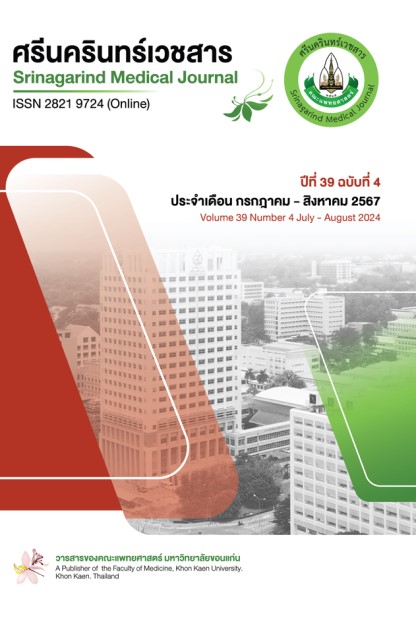Leading Causes to Visit Emergency Department in the Last Month of Life of Palliative Patients in a Super Tertiary Hospital
Keywords:
emergency department, palliative care, leading causes, super tertiary hospitalAbstract
Background and objective: Palliative patients have multiple complex distress and disease burden, especially in the last month of life. Leading cause to visit the emergency department (ED) need to be explored. This study aimed to investigate factors related to visit emergency department in super tertiary hospital among palliative patients in the last month of life.
Methods: A descriptive retrospective study was conducted by reviewing medical record review of patients who visited Srinagarind hospital ED in the last month of life and received palliative care service from Karunruk Palliative Care Center, Srinagarind Hospital, Khon Kaen University, Thailand between 1 January to 30 June 2022.
Results: 115 palliative patients went to ED in the last month of life. Mean average age was 66.65 years. The most diagnoses were hepato-biliary cancer 60.0 %, non-cancer disease 40.0 % Symptoms distress which bring patients to ED were dyspnea 31.3%, severe pain 28.7 % and decreased level of consciousness 22.60 %. More than half of patients came from rural areas or other provinces 58.26%. Patients visited ED by ambulance was 53.9 %, by private transportation was 46.1% and 78.9 % accessed to ED in the daytime (8 am – 4 pm). Family and caregiver issues were anxiety, unable to accept death, need life support and over expectation for cure, unable to deal with patient’s symptoms at home (86.1 %), unable to died at home (11.30%), and inconsistent care plan (2.58%). Most patients (93.91) had their own advanced care planning and preferred comfort care 72.2%. After visited emergency room, 33.9% of patients were sent to palliative ward. 49.5% admitted to internal medicine ward for correcting causes, 2.6% referred to other hospitals, 7.8% referred to rural areas or other provinces, 3.5% discharged for Karunrak home care, and 2.6% died at the emergency room.
Conclusion: Domicile symptom burden, multiple complex diseases, and family caregiver anxiety are the factors that often lead patients to visit the emergency room. There is a risk of death during transfer to the hospital, and some patients have died at the emergency room. This study is suitable to develop care plan for palliative patients by creating emergency practice guidelines for services in rural areas and other provinces. Implementing this strategic plan may help reduce unnecessary ED visits.
References
Theerachol S, Matchim Y. End-of-life care: The context of the emergency room. Vajira Nursing Journal 2018;19(1):1–9.
Chang A, Espinosa J, Lucerna A, Parikh NP. Palliative and end-of-life care in the emergency department. Clin Exp Emerg Med 2022; 9(3):253-6. doi: 10.15441/ceem.22.341.
Verhoef M, Nijs E, Horeweg N, Fogteloo J, Heringhaus C. Palliative care needs of advanced cancer patients in the emergency department at the end of life: An observational cohort study. Support Care Cancer 2020;28(3):1097-1107. doi: 10.1007/s00520-019-04906-x.
Sriveing P, Parichart P. Operation guidelines for hospital palliative care program. Khon Kaen: Kungnanawithaya; 2014.
Sadler K, Abudari G, Aljawi D, Snelling D. Deaths in the Emergency Department: An Assessment of Patient's End-of-Life Trajectory and Quality of Care. Indian J Palliat Care 2020 Jul-Sep;26(3):352-357. doi: 10.4103/IJPC.IJPC_206_19.
Monsomboon A, Chongwatcharasatit T, Chanthong P, Chakorn T, Prapruetkit N, Surabenjawong U, et al. Characteristics and factors associated with mortality in palliative patients visiting the Emergency Department of a large tertiary hospital in Thailand. BMC Palliat Care. 2022;21(1):115-124. doi: 10.1186/s12904-022-01009-z.
Karunruk Palliative Care Center. Annual report of the Karunruk Palliative Care Center statistics. Srinagarind Hospital, Faculty of Medicine, Khon Kaen University, 2020.
Lee J, Kim J, Park I, Cho Y. Factors associated with the number of emergency department visitors. J EMS Med 2021;1(1):23-30. doi:10.35616/jemsm.2019.00031.
Tianthong S, Pirojkul S, Piasupan P. Readmission of palliative patients at Karunruk Palliative Center, Srinagarind Hospital. Srinagarind Med J 2021;36(4):469-473.
Taylor P, Stone T, Simpson R, Kyeremateng S, Mason S. Emergency department presentations in palliative care patients: a retrospective cohort study. BMJ Support Palliat Care 2022 ;1-4. doi:10.1136/bmjspcare-2022-003563.
Wallace EM, Cooney MC, Walsh J, Conroy M, Twomey F. Why do palliative care patients present to the emergency department? Avoidable or unavoidable? Am J Hosp Palliat Care 2013;30(3):253-6. doi:10.1177/1049909112447285.
Downloads
Published
How to Cite
Issue
Section
License
Copyright (c) 2024 Srinagarind Medical Journal

This work is licensed under a Creative Commons Attribution-NonCommercial-NoDerivatives 4.0 International License.




